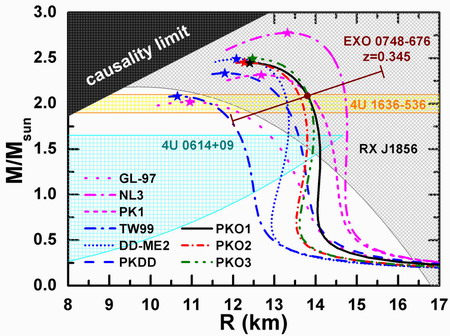Title: Neutron star properties in density-dependent relativistic Hartree-Fock theory
Author(s): Bao Yuan Sun (孙保元), Wen Hui Long (龙文辉), Jie Meng (孟杰), and U. Lombardo
Source: Physical Review C
Volume: 78 Issue: 6 Page: 065805 Published: 31 December 2008
KeyWords Plus: MEAN-FIELD THEORY; ASYMMETRIC NUCLEAR-MATTER; NONLINEAR SIGMA-TERM; HEAVY-ION REACTIONS; GROUND-STATE; BOGOLIUBOV THEORY; RECENT PROGRESS; SHELL STRUCTURE; EXOTIC NUCLEI; FINITE NUCLEI
History: Received 7 October 2008
DOI: 10.1103/PhysRevC.78.065805
Abstract: With the equations of state provided by the newly developed density-dependent relativistic Hartree-Fock (DDRHF) theory for hadronic matter, the properties of the static and β-equilibrium neutron stars without hyperons are studied for the first time and compared to the predictions of the relativistic mean-field models and recent observational data. The influences of Fock terms on properties of asymmetric nuclear matter at high densities are discussed in detail. Because of the significant contributions from the σ- and ω-exchange terms to the symmetry energy, large proton fractions in neutron stars are predicted by the DDRHF calculations, which strongly affect the cooling process of the star. A critical mass of about 1.45Mo, close to the limit of 1.5Mo determined by modern soft X-ray data analysis, is obtained by DDRHF with the effective interactions PKO2 and PKO3 for the occurrence of the direct Urca process in neutron stars. The maximum masses of neutron stars given by the DDRHF calculations lie between 2.45Mo and 2.49Mo, which are in reasonable agreement with the high pulsar mass of (2.08+/-0.19)Mo from PSR B1516+02B. It is also found that the mass-radius relations of neutron stars determined by DDRHF are consistent with the observational data from thermal radiation measurements in the isolated neutron star RX J1856, quasiperiodic brightness oscillations in the low-mass X-ray binaries 4U 0614+09 and 4U 1636-536, and the redshift determined in the low-mass X-ray binary EXO 0748-676.

Figure: Mass-radius relations of neutron stars provided by the DDRHF and RMF calculations and the corresponding maximum masses ( marked by filled star symbols). For comparison are also shown the four separate observational constraints from RX J1856 (gray grided region), 4U 0614 + 09 (cyan grided area), 4U 1636-536 (yellow grided area), and EXO 0748-676 (error bar for 1σ error). The black region is excluded by causality that R > 2.9GM/c2.
>> View Full Text <<
